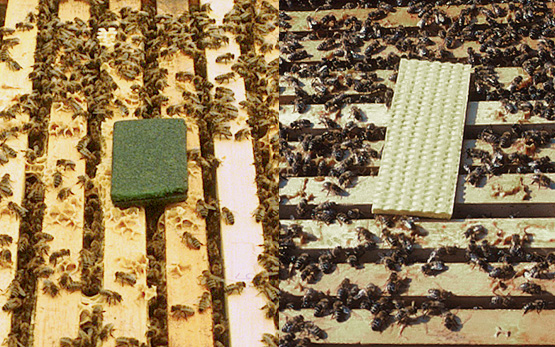Guichard M., Dainat B., Dietemann V.
Natürliche Selektion - ein Wundermittel gegen die Varroamilbe?
Schweizerische Bienen-Zeitung, 9, 2023, 23-27.
Guichard M., Dietemann V.
Die Winterbehandlung, ein Eckpfeiler des Varroabekämpfungskonzepts.
Schweizerische Bienen-Zeitung, 10, 2023, 24-27.
Bult I., Dietemann V., Guichard M., Ritter R.
Gespenster-Drohnen.
Schweizerische Bienen-Zeitung, 9, 2023, 13-15.
Guichard M., Dietemann V.
Stellungnahme zum Referat «Krankheitsresistente Bienen ohne Chemie – zurück zur Urbiene».
Beiheft Schweizerische Bienenzeitung, 6, 2023, 65-66.
Ory F., Dietemann V., Guisolan A., Von Ah U., Fleuti C., Oberhaensli S., Charrière J.-D., Dainat B.
Paenibacillus melissococcoides sp. nov., isolated from a honey bee colony affected by European foulbrood disease.
International Journal of Systematic and Evolutionary Microbiology, 73, (4), 2023, 1-10.
Charrière J.-D., Dietemann V., Dainat B.
Leitfaden Bienengesundheit des Zentrums für Bienenforschung.
Agroscope Transfer, 502, 2023, 1-45.
weitere Sprachen: französisch | italienisch
Facchini E., Dietemann V., Elllis J. D., Evans J. D., Neumann P., Carreck N.
The coloss beebook: An example of standard methods in insect research.
Journal of Insects as Food and Feed, In Press, 2023, 1-5.
Hernandez J., Varennes Y.-D., Aebi A., Dietemann V., Kretzschmar A.
Mesures agroécologiques dans les prairies : Quels impacts sur les abeilles domestiques ?
La Santé de l'Abeille, 317, 2023, 41-50.
Dainat B., Oberhaensli S., Ory F., Dietemann V.
New reference genomes of honey bee-associated bacteria Paenibacillus melissococcoides, Paenibacillus dendritiformis, and Paenibacillus thiaminolyticus.
Microbiology Resource Announcements, In Press, 2023, 1-4.
Guichard M., Dainat B., Dietemann V.
La sélection naturelle – une solution miracle face au varroa?
Revue Suisse d'apiculture, 144, (7), 2023, 287-292.
Hernandez J., Varennes Y.-D., Aebi A., Dietemann V., Kretschmar A.
Agroecological measures in meadows promote honey bee colony development and winter survival.
Ecosphere, 14, (2), 2023, 1-13.
Guichard M., Dainat B., Dietemann V.
Prospects, challenges and perspectives in harnessing natural selection to solve the ‘varroa problem’ of honey bees.
Evolutionary Applications, 16, (3), 2023, 593-608.
Grossar D., Haynes E., Budge G. E., Parejo M., Gaultier L., Charrière J.-D., Chapuisat M., Dietemann V.
Population genetic diversity and dynamics of the honey bee brood pathogen Melissococcus plutonius in a region with high prevalence.
Journal of Invertebrate Pathology, 196, 2023, 1-8.
von Virag A., Guichard M., Neuditschko M., Dietemann V., Dainat B.
Unterdrückte Milbenvermehrung als Selektionsmerkmal?
Schweizerische Bienen-Zeitung, 11, 2022, 14-16.
weitere Sprachen: französisch
de la Harpe M., Guetlin A., Chiang C., Dietemann V., Dainat B.
Influence of honey bee nutritive jelly type and dilution on its bactericidal effect on Melissococcus plutonius, the etiological agent of european foulbrood.
Microbial Ecology, 2022, 1-7.
Zheng H., Wang S., Wu Y., Zou S., Dietemann V., Neumann P., Chen Y., Li-Byarlay H., Pirk C., Evans J., Hu F., Feng Y.
Genomic signatures underlying the oogenesis of the ectoparasitic mite Varroa destructor on its new host Apis mellifera.
Journal of Advanced Research, online, (4 May), 2022, 1-11.
Ory F., Duchemin V., Kilchenmann V., Charrière J.-D., Dainat B., Dietemann V.
Can trans-generational immune priming be used to protect honey bees against European foulbrood.
In: EurBee 9 – 9th European Congress of Apidology. 20-22 September, Hrsg. EurBee, Belgrade. 2022, 97.
Ameline C., Beaurepaire A., Ory F., de la Harpe M., Dainat B., Dietemann V.
Differential resistance across paternal genotypes of honey bee brood to the pathogenic bacterium Melissococcus plutonius.
Journal of Applied Entomology, online, (6 October), 2022, 1-9.
von Virag A., Guichard M., Neuditschko M., Dietemann V., Dainat B.
Suppressed mite reproduction SMR: An efficient tool to select Varroa destructor resistant honey bee?
In: 69. Jahrestagung der Arbeitsgemeinschaft der Institute für Bienenforschung e.V.. 5. - 7. April, Hrsg. Universität Hohenheim, Bad Überkingen-Oberböhringen. 2022.
Charrière J.-D., Dietemann V., Kast C., Droz B., Dainat B., Grossar D., Jeker L.
Was lief im Jahr 2021 am Zentrum für Bienenforschung?
Schweizerische Bienen-Zeitung, 8, 2022, 20-27.
weitere Sprachen: französisch






